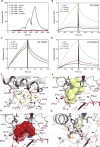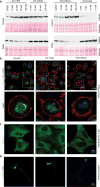The synthetic diazonamide DZ-2384 has distinct effects on microtubule curvature and dynamics without neurotoxicity
- PMID: 27856798
- PMCID: PMC5291303
- DOI: 10.1126/scitranslmed.aag1093
The synthetic diazonamide DZ-2384 has distinct effects on microtubule curvature and dynamics without neurotoxicity
Erratum in
-
Erratum for the Research Article: "The synthetic diazonamide DZ-2384 has distinct effects on microtubule curvature and dynamics without neurotoxicity" by M. Wieczorek, J. Tcherkezian, C. Bernier, A. E. Prota, S. Chaaban, Y. Rolland, C. Godbout, M. A. Hancock, J. C. Arezzo, O. Ocal, C. Rocha, N. Olieric, A. Hall, H. Ding, A. Bramoullé, M. G. Annis, G. Zogopoulos, P. G. Harran, T. M. Wilkie, R. A. Brekken, P. M. Siegel, M. O. Steinmetz, G. C. Shore, G. J. Brouhard, A. Roulston.Sci Transl Med. 2017 Dec 20;9(421):eaar6760. doi: 10.1126/scitranslmed.aar6760. Sci Transl Med. 2017. PMID: 29263229 No abstract available.
Abstract
Microtubule-targeting agents (MTAs) are widely used anticancer agents, but toxicities such as neuropathy limit their clinical use. MTAs bind to and alter the stability of microtubules, causing cell death in mitosis. We describe DZ-2384, a preclinical compound that exhibits potent antitumor activity in models of multiple cancer types. It has an unusually high safety margin and lacks neurotoxicity in rats at effective plasma concentrations. DZ-2384 binds the vinca domain of tubulin in a distinct way, imparting structurally and functionally different effects on microtubule dynamics compared to other vinca-binding compounds. X-ray crystallography and electron microscopy studies demonstrate that DZ-2384 causes straightening of curved protofilaments, an effect proposed to favor polymerization of tubulin. Both DZ-2384 and the vinca alkaloid vinorelbine inhibit microtubule growth rate; however, DZ-2384 increases the rescue frequency and preserves the microtubule network in nonmitotic cells and in primary neurons. This differential modulation of tubulin results in a potent MTA therapeutic with enhanced safety.
Copyright © 2016, American Association for the Advancement of Science.
Conflict of interest statement
Diazon Pharmaceuticals Inc. holds the rights to the Patent Cooperation Treaty publication no. WO2009/134938 that covers DZ-2384. None of the authors of this manuscript are named inventors on this patent. G.C.S., A.R., and P.H. are founders and shareholders in Diazon Pharmaceuticals Inc. R.A.B. and T.M.W. are founders of Tuevol Therapeutics Inc. and are inventors on patent applications (62/067,304; 62/067,276; 62/232,901; and 62/232,922) held or submitted by the UT Southwestern Medical Center that cover the use of the GEMM rapid in vivo assay (Rgs16∷GFP;KIC model) for screening therapeutics for pancreatic ductal adenocarcinoma.
Figures






Similar articles
-
Diazonamide A and a synthetic structural analog: disruptive effects on mitosis and cellular microtubules and analysis of their interactions with tubulin.Mol Pharmacol. 2003 Jun;63(6):1273-80. doi: 10.1124/mol.63.6.1273. Mol Pharmacol. 2003. PMID: 12761336
-
Sensitivity of docetaxel-resistant MCF-7 breast cancer cells to microtubule-destabilizing agents including vinca alkaloids and colchicine-site binding agents.PLoS One. 2017 Aug 7;12(8):e0182400. doi: 10.1371/journal.pone.0182400. eCollection 2017. PLoS One. 2017. PMID: 28787019 Free PMC article.
-
[Thermodynamics of calmodulin and tubulin binding to the vinca-alkaloid vinorelbine].Mol Biol (Mosk). 2011 Jul-Aug;45(4):697-702. Mol Biol (Mosk). 2011. PMID: 21954603 Russian.
-
Mechanism of action of antitumor drugs that interact with microtubules and tubulin.Curr Med Chem Anticancer Agents. 2002 Jan;2(1):1-17. doi: 10.2174/1568011023354290. Curr Med Chem Anticancer Agents. 2002. PMID: 12678749 Review.
-
Vinflunine: a new vision that may translate into antiangiogenic and antimetastatic activity.Anticancer Drugs. 2012 Jan;23(1):1-11. doi: 10.1097/CAD.0b013e32834d237b. Anticancer Drugs. 2012. PMID: 22027536 Review.
Cited by
-
Ascidian Toxins with Potential for Drug Development.Mar Drugs. 2018 May 13;16(5):162. doi: 10.3390/md16050162. Mar Drugs. 2018. PMID: 29757250 Free PMC article. Review.
-
The compound millepachine and its derivatives inhibit tubulin polymerization by irreversibly binding to the colchicine-binding site in β-tubulin.J Biol Chem. 2018 Jun 15;293(24):9461-9472. doi: 10.1074/jbc.RA117.001658. Epub 2018 Apr 24. J Biol Chem. 2018. PMID: 29691282 Free PMC article.
-
DZ-2384 has a superior preclinical profile to taxanes for the treatment of triple-negative breast cancer and is synergistic with anti-CTLA-4 immunotherapy.Anticancer Drugs. 2018 Sep;29(8):774-785. doi: 10.1097/CAD.0000000000000653. Anticancer Drugs. 2018. PMID: 29878901 Free PMC article.
-
Measurements of neurite extension and nucleokinesis in an iPSC-derived model system following microtubule perturbation.Mol Biol Cell. 2025 Jan 1;36(1):mr1. doi: 10.1091/mbc.E24-02-0061. Epub 2024 Nov 27. Mol Biol Cell. 2025. PMID: 39602292 Free PMC article.
-
An Indole-Chalcone Inhibits Multidrug-Resistant Cancer Cell Growth by Targeting Microtubules.Mol Pharm. 2018 Sep 4;15(9):3892-3900. doi: 10.1021/acs.molpharmaceut.8b00359. Epub 2018 Aug 9. Mol Pharm. 2018. PMID: 30048137 Free PMC article.
References
-
- Jordan MA, Wilson L. Microtubules as a target for anticancer drugs. Nat Rev Cancer. 2004;4:253–265. - PubMed
-
- Castedo M, Perfettini JL, Roumier T, Andreau K, Medema R, Kroemer G. Cell death by mitotic catastrophe: A molecular definition. Oncogene. 2004;23:2825–2837. - PubMed
-
- Musacchio A, Hardwick KG. The spindle checkpoint: Structural insights into dynamic signalling. Nat Rev Mol Cell Biol. 2002;3:731–741. - PubMed
MeSH terms
Substances
Grants and funding
LinkOut - more resources
Full Text Sources
Other Literature Sources

